California Native Sage Picture Gallery
Flowers by the Sea cultivates hardy, drought-tolerant plants California gardeners need for conservation and colorful wildlife garden design. We specialize in Salvias, including ones native to a broad swath of the West Coast from Northern Baja to Southern Oregon. This area is referred to as the California Floristic Province and has a mild, Mediterranean climate characterized by wet winters and dry summers.
The California natives detailed below are all drought resistant and many tolerate heat. They are well suited to low water xeriscapes, including dry gardens in which plants must survive despite almost no supplemental watering.
Most of these species need full sun while others love or at least tolerate partial shade. All need soil that drains well. They range from short, creeping groundcovers to herbaceous shrubs that reach up to five feet tall and are arranged according to color. All are among the best deer-resistant plants.
-
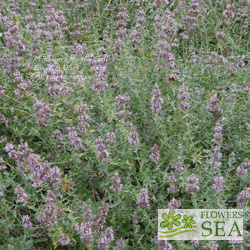
Salvia x 'Bee's Bliss'
-
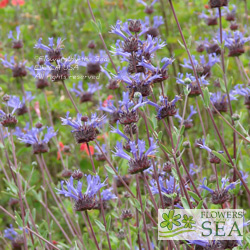
Salvia clevelandii 'Winnifred Gilman'
-
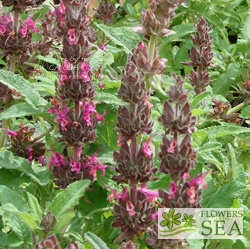
Salvia spathacea
-
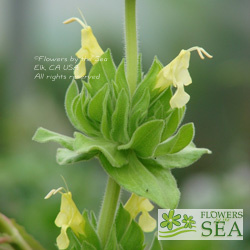
Salvia spathacea 'Avis Keedy'
-
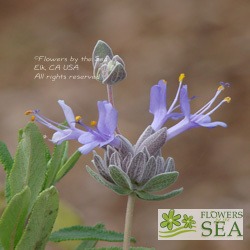
Salvia brandegeei
-
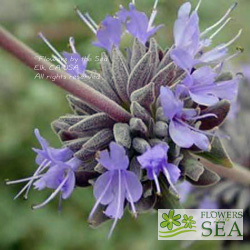
Salvia x 'Pozo Blue'
-
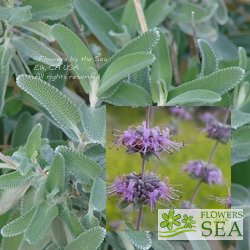
Salvia leucophylla
-
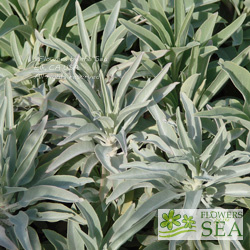
Salvia apiana
-
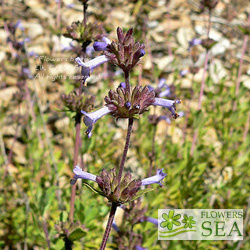
Salvia munzii
-
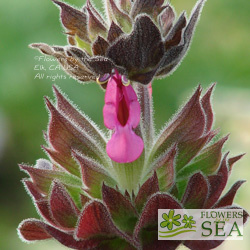
Salvia spathacea 'Topanga'
-
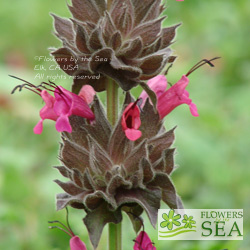
Salvia spathacea 'Powerline Pink'
-
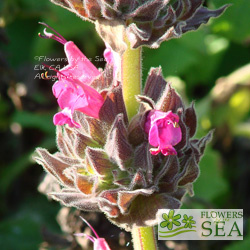
Salvia spathacea 'Las Pilitas'
-
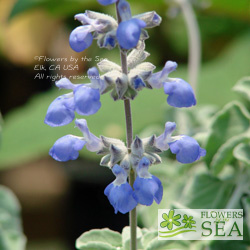
Salvia cedrosensis
-
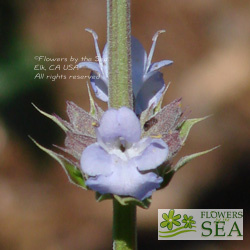
Salvia x 'Starlight'
-
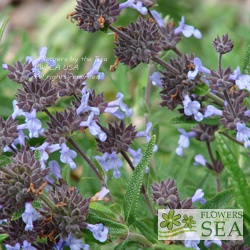
Salvia 'Dara's Choice'
-
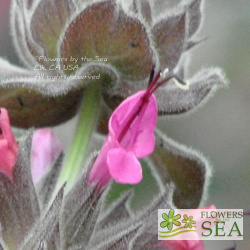
Salvia spathacea 'Elk Rose'
-
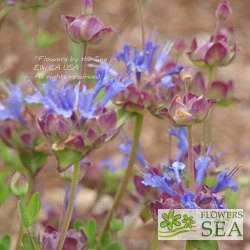
Salvia x 'Celestial Blue'
-
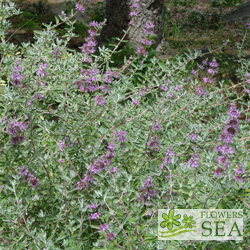
Salvia leucophylla 'Amethyst Bluffs'
-
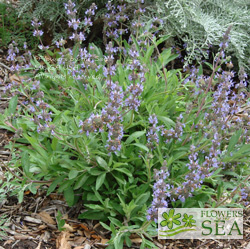
Salvia mellifera 'Terra Seca'
-
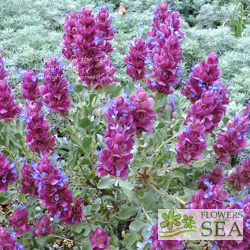
Salvia pachyphylla 'Blue Flame'
-
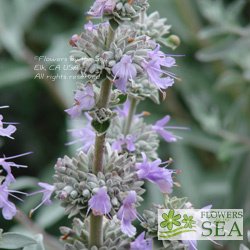
Salvia x 'Gayle Nielson'
-
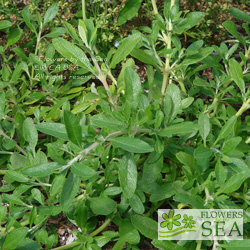
Salvia mellifera 'Jade Carpet'
-
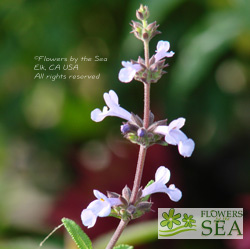
Salvia brandegeei x munzii 'Pacific Blue'
-
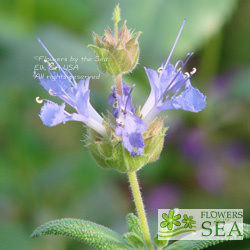
Salvia eremostachya
-
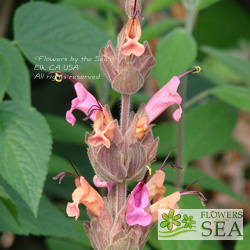
Salvia spathacea 'Apricot Rose'
-
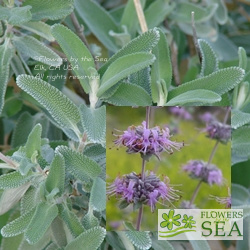
Salvia leucophylla 'Point Sal Spreader'
-
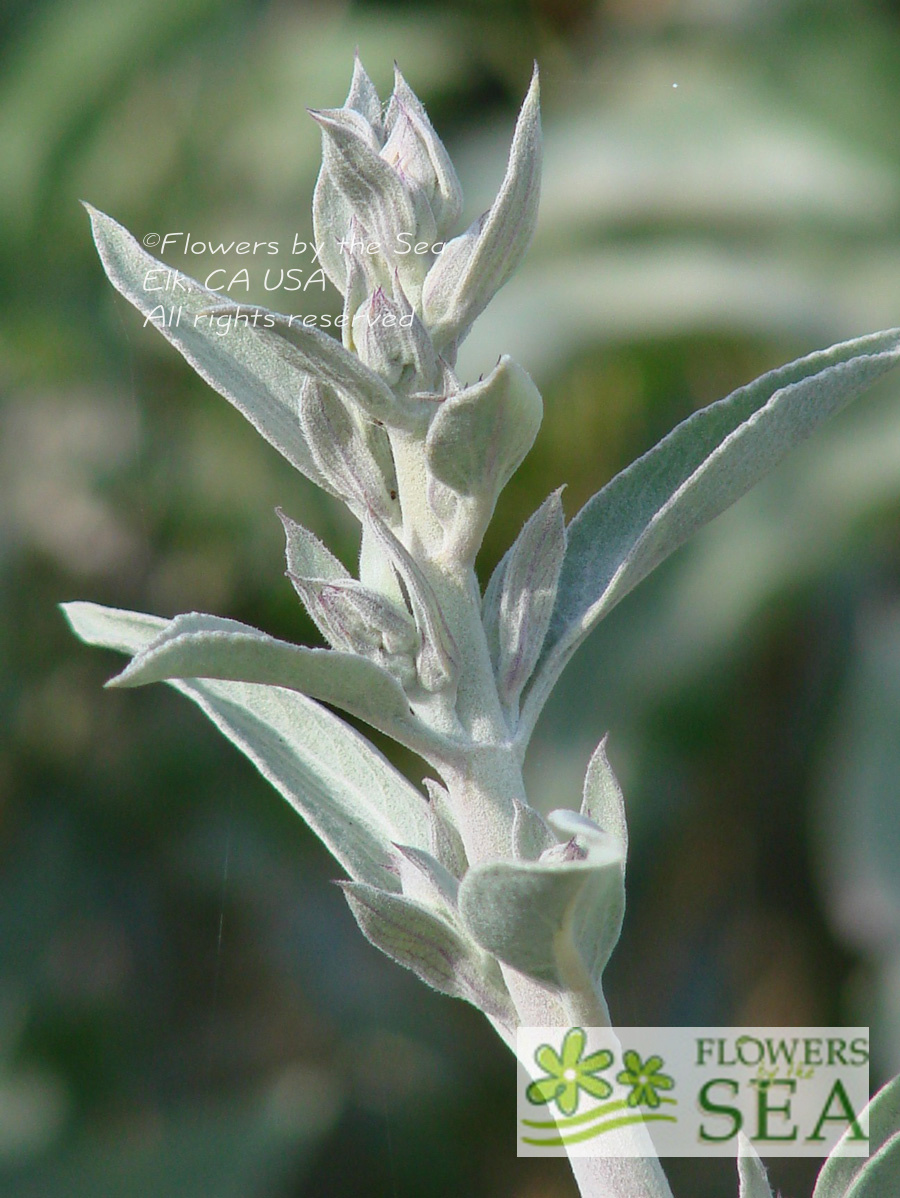
Salvia apiana var. compacta
Related Blog entries for plants in the California Native Sage Picture Gallery
Ask Mr. Sage answers questions based on calls and emails that Flowers by the Sea receives, such as concerns about what Salvias will grow in clay soils. This article talks about specific plants for dry and wet clay conditions, how to improve soil drainage and planting on slopes in wet areas.
White Sage (Salvia apiana) is a sacred plant for Native Americans, especially tribes in its Southern California native lands. It's a challenging plant to grow. Flowers by the Sea Farm and Nursery talks about the history and religious use of Salvia apiana as well as providing a guide to growing it.
Native plants, including California's many indigenous sages, are like the boys or girls next door who were overlooked until outsiders discovered their good looks and other fine attributes. Flowers by the Sea grows hardy, drought-resistant California Salvias that are native to a broad swath of the West Coast ranging from Northern Baja to Southern Oregon. Many tolerate heat. They are well suited to waterwise landscapes, including dry gardens.
If you want to orchestrate a peaceful symphony in a flowerbed, planting a profusion of pastels is one way to do it. Pastels are lighter hues of bright primary and secondary colors. Although gardeners often visualize bright colors when thinking of Salvias, there are a number of pastels in the genus such as among the Jame Sage Hybrids (Salvia x jamensis spp.), including many in the new Flowers by the Sea Elk Rainbow Series.
Deadheading spent Salvia flowers helps to prolong bloom time. However, if you enjoy the company of songbirds and game birds in your garden, let some of the flower spikes go to seed, especially at the end of the plant's flowering season.
Native plants are the best ones for local conditions. But sometimes boundaries designating what is native may be artificial. Here are five outstanding Xeric Salvias for Southern California, including one, not far over the Baja border, that offers intense drought resistance and violet-blue flowers.
Quick Digs is a serial containing short posts focused on a central issue about Salvia gardening. The topic for the first series is Salvia groundcovers for weed control, and this is the first article. Great groundcovers help conserve soil moisture and leave little room for weeds to grow. This is true of many colorful, fragrant Salvias that spread freely. However, it may be that the essential oils creating the pleasant aromas of many Salvias are also helpful in suppressing weeds. Many researchers refer to this apparent trait as the “Salvia phenomenon.”
Regional differences in seasonal temperature and humidity affect the choice of Salvias to plant in hummingbird gardens. The varying seasons in which particular sages bloom and the part of the world where they originated also determine whether they attract hummingbirds. Flowers by the Sea Online Nursery offers suggestions based on regions and seasons.
Ask anyone to describe the American Southwest, and they're likely to sum it up in three letters : "D-R-Y." Yet precipitation can vary a lot here state by state and even within different parts of the individual states. One thing that is consistent about the story of water throughout the Southwest, is that rain and snow can rapidly swing from famine to feast to misfortune.
Among the hummers' favorites: Salvia spathacea, commonly known as Hummingbird Sage. As it name suggests, this California native produces the hummingbirds' flower of choice, blooming from late winter through summer -- and sometimes again in Fall -- with rose-pink to magenta blossoms. Available in six varieties, this robust perennial not only attracts hummers with its abundant nectar, it's easy to grow and enhances any landscape with its aromatic blooms and fragrant evergreen foliage.
Less than 250 years ago, Black Sage and White Sage also helped feed and heal the Tongvas and other Southern California native peoples. Here is their story.
Flowers by the Sea grows a number of native California sages, including threatened species such as the woody perennial shrubs Santa Rosa Island Sage (Salvia brandegeei) and Island Pitcher Sage (Lepechinia fragrans). Elusive is one adjective to attach to both plants, because they are rare in their native Channel Islands homelands off the coast of Southern California where they are endangered.
Most native plant gardens encompass species native to the region or state in which a gardener lives. However, some native gardens -- such as the New England Wild Flower Society's famous Garden in the Woods -- are based on a broad variety of plants native across America.
A California native sage that looks like it is suffering from drought may actually have root disease caused by a water mold called Phytophthora. Natives are affected by types of this pathogen that strike when soil is moist and temperatures are hot. Ask Mr. Sage is a regular feature of the Everything Salvias Blog and is based on calls and emails from customers.
Bees and hummingbirds love the perennial subshrub Sacred White Sage (Salvia apiana) with its soaring spikes of white-to-lavender flowers that visually cool the landscape along with its large rosettes of lance-shaped, greenish-white foliage. Sacred White Sage is far more than a pretty native plant of California. Historically, it provided food and medicine for a number of Native American tribes along the Pacific Coast. Today, bundles of Sacred White Sage leaves are still tied together to create torch-like wands called smudge sticks for fragrant purification ceremonies far beyond the Native American community.
Drought resistant California native sages thrive when planted in fall. It's easier for roots to become established when soil is warm, air temperatures are cooler and precipitation is increasing. Ask Mr. Sage is a regular feature of the Everything Salvias Blog and is based on calls and emails from customers.
Long before the West Coast was colonized, California Indians used Black Sage (Salvia mellifera Greene) for food and medicinal purposes. Today, it often is bundled in smudge sticks used like incense during purification rituals. Another reason to consider Black Sage sacred is that, among the state’s native plants, it is one of the most important sources of nectar for pollinators. Nineteenth century botanist and clergyman Edward Lee Greene made the plant’s botanical name official in 1892 when he was the first person to publish it in a scientific journal. Among California's native Salvias, it is the easiest to grow in home gardens.
Weeding is the topic of this fourth article in our Quick Digs series about preparing for spring in Salvia gardens. Getting ready for the emergence of previously planted perennials in spring and for planting new sages (Salvia spp.) requires weeding before amending soil and planting. Then, growing vigorously spreading sages and ones rich in aromatic plant chemicals called terpines can help control weeds.
| Name | Mature height | Mature width | Flower color | Bract color | Exposure |
|---|---|---|---|---|---|
| Salvia x 'Bee's Bliss' | 1 to 2 feet | 1 to 2 feet | Not yet defined * | Not yet defined * | Full sun |
| Salvia clevelandii 'Winnifred Gilman' | 3 to 4 feet | 3 to 4 feet | Not yet defined * | Not yet defined * | Full sun |
| Salvia spathacea | 1 to 2 feet | 1 to 2 feet | Not yet defined * | Not yet defined * | Full sun to partial shade |
| Salvia spathacea 'Avis Keedy' | 1 to 2 feet | 2 to 3 feet | Light Greenish Yellow | Strong Yellowish Green | Full sun to partial shade |
| Salvia brandegeei | 2 to 3 feet | 2 to 3 feet | Not yet defined * | Not yet defined * | Full sun |
| Salvia x 'Pozo Blue' | 2 to 3 feet | 2 to 3 feet | Not yet defined * | Not yet defined * | Full sun |
| Salvia leucophylla | 3 to 4 feet | 3 to 4 feet | Not yet defined * | Not yet defined * | Full sun |
| Salvia apiana | 4 to 5 feet | 4 to 5 feet | Yellowish white | Yellowish Gray | Full sun |
| Salvia munzii | 3 to 4 feet | 3 to 4 feet | Not yet defined * | Not yet defined * | Full sun |
| Salvia spathacea 'Topanga' | 1 to 2 feet | 1 to 2 feet | Deep Pink | Moderate Purplish Red | Partial shade |
| Salvia spathacea 'Powerline Pink' | 3 to 4 feet | 3 to 4 feet | Vivid Purplish Red | Moderate Red | Partial shade |
| Salvia spathacea 'Las Pilitas' | 1 foot or less | 1 foot or less | Strong Purplish Red | Dark Red | Partial shade |
| Salvia cedrosensis | 2 to 3 feet | 2 to 3 feet | Strong Purplish Blue | Light Greenish Gray | Full sun |
| Salvia x 'Starlight' | 3 to 4 feet | 3 to 4 feet | Not yet defined * | Not yet defined * | Full sun |
| Salvia 'Dara's Choice' | 1 to 2 feet | 6 feet plus | Light Purplish Blue | Dark Red | Full sun |
| Salvia spathacea 'Elk Rose' | 2 to 3 feet | 2 to 3 feet | Strong Purplish Red | Dark Red | Partial shade |
| Salvia x 'Celestial Blue' | 2 to 3 feet | 2 to 3 feet | Not yet defined * | Not yet defined * | Full sun |
| Salvia leucophylla 'Amethyst Bluffs' | 6 feet plus | 6 feet plus | Not yet defined * | Not yet defined * | Full sun |
| Salvia mellifera 'Terra Seca' | 1 to 2 feet | 5 to 6 feet | Not yet defined * | Not yet defined * | Full sun |
| Salvia pachyphylla 'Blue Flame' | 2 to 3 feet | 2 to 3 feet | Not yet defined * | Not yet defined * | Full sun |
| Salvia x 'Gayle Nielson' | 3 to 4 feet | 3 to 4 feet | Not yet defined * | Not yet defined * | Full sun |
| Salvia mellifera 'Jade Carpet' | 1 to 2 feet | 5 to 6 feet | Very Pale Violet | Dark Red | Full sun |
| Salvia brandegeei x munzii 'Pacific Blue' | 2 to 3 feet | 2 to 3 feet | Light Violet | Dark Red | Full sun |
| Salvia eremostachya | 2 to 3 feet | 2 to 3 feet | Strong Violet | Brilliant Purplish Blue | Full sun |
| Salvia spathacea 'Apricot Rose' | 1 to 2 feet | 1 to 2 feet | Not yet defined * | Not yet defined * | Full sun to partial shade |
| Salvia leucophylla 'Point Sal Spreader' | 2 to 3 feet | 6 feet plus | Not yet defined * | Not yet defined * | Full sun |
| Salvia apiana var. compacta | 2 to 3 feet | 2 to 3 feet | Not yet defined * | Not yet defined * | Full sun |
